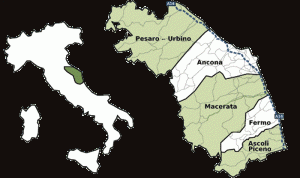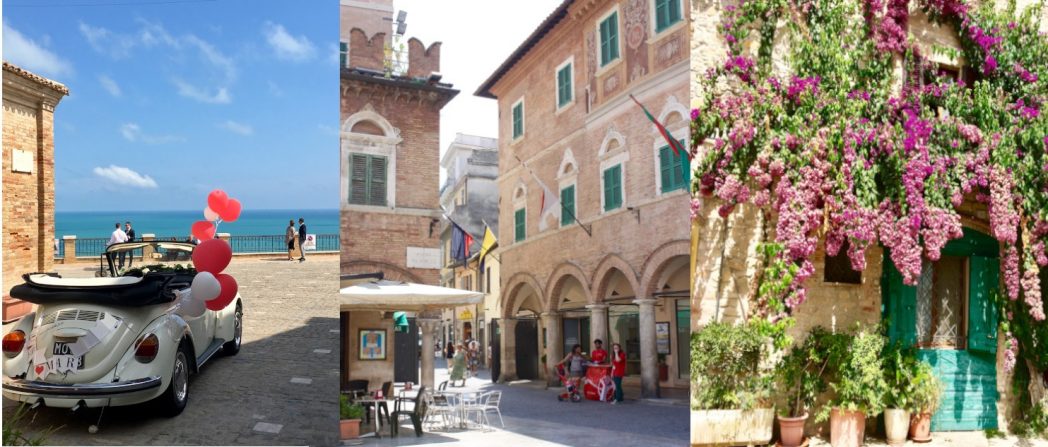Some information about the Le Marche Region
The Region of Le Marche
Le Marche is situated in Central Italy along the Adriatic Coast. It boasts long beaches, rolling hills and snow-peaked mountains. Known as “The Secret Marche” it is the preferred holiday destination of Romans (ancient and modern) who would come to it’s beaches and countryside to escape the soaring heat in the summer. With a more temperate climate and more varied landscape it has become a popular destination with foreign travellers recently too. Despite the increase of tourism to the area it has not lost any of it’s charm or rural appeal. Le Marche enjoys a rich traditional cuisine incorporating it’s fresh local roduce, including White Truffels, wild boar and wine.
The Adriatic coast with beautiful beaches is a 30 minutes drive and the Sibillini National Park with mountain lakes and scenic walks is 20 minutes from The Retreat. The Roman city of Ascoli Piceno on the Via Salaria connecting Rome with the Adriatic is 24 km away. It has a magnificient cathedral boasting an original Crivelli Altar piece, Roman towers, and beautiful squares. During the months of July and August a traditional Palio called the “Quintana” is held with processions with medieval costumes and rituals culminating in a jousting competition between participating towns and villages.

Ascoli Piceno
Southern Le Marche’s provincial capital boasts a wealth of classical squares and historical buildings dating back to Roman times. The Duomo houses an original Crivelli Tryptic, only one of the many Renaissance masterpieces created in this region. During the summer months the town becomes alive with it’s annual Quintana, a medieval palio featuring many costume parades and events in historical settings throughout the town. It is a traditional competition between the sestiere of the city culminating in a lancing competition on horses between the sestiere, or districts of Ascoli. Read more about Ascoli Piceno. You can enjoy many of the events free of charge and use this opportunity to explore this magnificent town on a day out.
Watch this video from Marche Tourism to see the fantastic painting opportunities for guests
Macerata
Known across the world for its annual open-air opera festival, but Macerata is a city that also warrants a visit for its other charms. Macerata was founded in the 6th century and it’s origins date back to the Visigoth influences. The many squares, it’s fine Palazzos and churches speak of it’s rich cultural and historical past. It is an ideal destination for an inspiring day out. Must see places include, Lo Sferito – the grand neoclassical open-air opera arena seating 7000 people, the remains of the nearby Roman City of Helvia Ricina and Corso Matteoti a street lined with historical palazzos in the town centre and Loggia dei Mercanti.
Urbino
Urbino remains one of the most important towns in the Marche – indeed in Italy – for the tourist in search of great Italian art and architecture and its beguiling streets will reward the curious traveller. Its centro storico is included in the UNESCO list of World Heritage Sites.
For the second half of the 15thC its windy hill was the setting for one of the most illustrious courts in Europe. Duke Federico da Montefeltr, Renaissance lord of the city. He gathered around him the greatest painters, poets and scholars of his day and housed them in one of Italy’s most beautiful Renaissance palaces, a palace that still stands as an eloquent memorial to this quintessential Renaissance man.
Thanks to a refined cultural education, Federico da Montefeltro was able to summarize in this territory the cream of the Italian renaissance humanistic culture. He tried to make his house the abode of the Muses and to this end he welcomed to his house the best artists of that time: Piero della Francesca, Luciano Laurana, Leon Battista Alberti and Francesco di Giorgio Martini. In this cradle of culture, artists such as Raphael and Bramante took their first steps. After the Renaissance, the city experienced new glory at the beginning of the 18th century, after the election to the papacy of Clement XI, son of the princely Albani family.
Loreto
Heading north along the Adriatic one is able to see the magnificient basilica of Loreto. This striking hill top town hosts one of the most important shrines to the cult of the Virgin Mary.
The great dome of the Sanctuario della Santa Casa dominates the countryside for miles around; below it stands the focus of piety – the rustic cottage from Nazareth that witnessed the Annunciation and the childhood of Jesus. Although the Santa Casa arrived, according to tradition, in 1294, it was not until 1507 that the church finally approved of Loreto as a place of pilgrimage.
For more information on our area view or download the official Le Marche Tourist Board Brochure click the link: Le Marche Brochure
Florence

